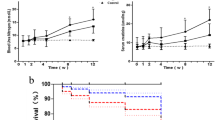Summary
This study examined the effect of sulodexide on podocyte injury in rats with adriamycin nephropathy (AN). A total of 36 healthy male SD rats were randomly assigned to three groups: control group, AN group and sulodexide treatment group. Rat models of AN were established by a single tail intravenous injection of adriamycin (6.5 mg/kg) in both AN group and sulodexide treatment group. Sulodexide (10 mg/kg) was administered the rats in the treatment group once daily by garage from the first day of model establishment until the 14th day or the 28th day. Samples of 24-h urine and renal cortex tissues were harvested at day 14, 28 after the model establishment. Excretion of 24-h urinary protein was measured by Coomassie brilliant blue method. The pathological changes in renal tissues were observed by light microscopy and electron microscopy respectively. Heparanase mRNA was detected by RT-PCR. Expressions of desmin, CD2AP and heparanase were determined by immunohistological staining. The results showed that the expressions of heparanase mRNA and protein were increased in the glomeruli of AN rats at day 14 and 28 after the model establishment, which was accompanied by the increased expression of desmin and CD2AP. The mRNA and protein expression of heparanase was decreased in the sulodexide-treated rats as compared with AN rats at day 14 and 28. And, the protein expression of desmin and CD2AP was reduced as with heparanase in the sulodexide- treated rats. Proteinuria and podocyte foot process effacement were alleviated in the AN rats after sulodexide treatment. There was a positive correlation between the expression of heparanase and the expression of desmin and CD2AP (as well as 24-h urinary protein excretion). It was concluded that increased heparanase is involved in podocyte injury. Sulodexide can maintain and restore podocyte morphology by inhibiting the expression of heparanase in AN.
Similar content being viewed by others
References
Shankland SJ. The podocyte’s response to injury: role in proteinuria and glomerulosclerosis. Kidney Int, 2006, 69(12):2131–2147
Patrakka J, Tryggvason K. New insights into the role of podocytes in proteinuria. Nat Rev Nephrol, 2009, 5(8):463–468
Wijnhoven TJ, Lensen JF, Rops AL, et al. Anti-proteinuric effects of glycosaminoglycan-based drugs. Curr Opin Mol Ther, 2007, 9(4):364–377
Coccheri S, Scondotto G, Agnelli H. Oral sulodexide reduces albuminuria in microalbuminuric and macroalbuminuric type 1 and type 2 diabetic patients: the Di.N.A.S. randomized trial. J Am Soc Nephrol, 2002,13(6):1615–1625
Lewis EJ, Xu X. Abnormal glomerular permeability characteristics in diabetic nephropathy: implications for the therapeutic use of low-molecular weight heparin. Diabetes Care, 2008, 31(2):202–207
Vilayur E, Harris DC. Emerging therapies for chronic kidney disease: what is their role? Nat Rev Nephrol, 2009, 5(7):375–383
Gheorghe G, Adalbert S, Marius R. The effects of the therapy with natural glycosaminoglycans (sulodexide) on proteinuria in different types of glomerulorphritis. Facta Universitatis Series: Medicine and Biology, 2001, 8(1):26–30
Smith RJ, Alexander J, Barlow PN, et al. New approaches to the treatment of dense deposit disease. J Am Soc Nephrol, 2007, 18(9):2447–2456
Xing Y, Ding J, Fan Q, et al. Diversities of podocyte molecular changes induced by different antiproteinuria drugs. Exp Biol Med, 2006, 231(5):585–593
Daniels B, Linhardt RJ, Zhang F, et al. In vivo antithrombotic synergy of oral heparin and arginine: endothelial thromboresistance without changes in coagulation parameters. Thromb Haemost, 2006, 95(5):865–872
Ceol M, Nerlich A, Baggio B, Anglani, et al. Increased glomerular alpha 1 (IV) collagen expression and deposition in long-term diabetic rats is prevented by chronic glycosaminoglycan treatment. Lab Invest, 1996, 74(2):484–495
Ciszewicz M, Polubinska A, Antoniewicz A, et al. Sulodexide suppresses inflammation in human endothelial cells and prevents glucose cytotoxicity. Transl Res, 2009, 153(3):118–123
Ceol M, Gambaro G, Sauer U, et al. Glycosaminoglycan therapy prevents TGF-beta1 overexpression and pathologic changes in renal tissue of long-term diabetic rats. J Am Soc Nephrol, 2000, 11(12):2324–2336
Asanuma K, Yanagida-Asanuma E, Takagi M. The role of podocytes in proteinuria. Nephrology, 2007, 12(3):15–20
Deegens JK, Dijkman HB, Borm GF, et al. Podocyte foot process effacement as a diagnostic tool in focal segmental glomerulosclerosis. Kidney Int, 2008, 74(12):1568–1576
Zou J, Yaoita E, Watanabe Y. Upregulation of nestin, vimentin, and desmin in rat podocytes in response to injury. Virchows Arch, 2006, 448(4):485–492
Zheng CX, Chen ZH, Zeng CH, et al. Triptolide protects podocytes from puromycin aminonucleoside induced injury in vivo and in vitro. Kidney Int, 2008,74(5):596–612
Chuang PY, He JC. Signaling in regulation of podocyte phenotypes. Nephron Physiol, 2009,111(2):9–15
Kim JM, Wu H, Green G, et al. CD2-associated protein haploinsufficiency is linked to glomerular disease susceptibility. Science, 2003, 300(5623):1298–1300
Huber TB, Hartleben B, Kim J, et al. Nephrin and CD2AP associate with phosphoinositide 3-OH kinase and stimulate AKT-dependent signaling. Mol Cell Biol, 2003, 23(14):4917–4928
Zhang C, Jiang HJ, Chang Y, et al. Downregulation of CD2-associated protein impaired the physiological functions of podocytes. Cell Biol Int, 2009, 33(6):632–639
Levidiotis V, Freeman C, Tikellis C, et al. Heparanase is involved in the pathogenesis of proteinuria as a result of glomerulonephritis. J Am Soc Nephrol, 2004, 15(1):68–78
Levidiotis V, Kanellis J, Ierino FL, et al. Increased expression of heparanase in puromycin aminonucleoside nephrosis. Kidney Int, 2001, 60(4):1287–1296
van den Hoven MJ, Rops AL, Bakker MA. Increased expression of heparanase in overt diabetic nephropathy. Kidney Int, 2006, 70(12):2100–2108
van den Hoven MJ, Rops AL, Vlodavsky I. Heparanase in glomerular diseases. Kidney Int, 2007, 72(5):543–548
Author information
Authors and Affiliations
Additional information
This project was supported by a grant from the National Natural Sciences Foundation of China (No. 30500245).
Rights and permissions
About this article
Cite this article
Chen, S., Fang, Z., Zhu, Z. et al. Protective effect of sulodexide on podocyte injury in adriamycin nephropathy rats. J. Huazhong Univ. Sci. Technol. [Med. Sci.] 29, 715–719 (2009). https://doi.org/10.1007/s11596-009-0608-0
Received:
Published:
Issue Date:
DOI: https://doi.org/10.1007/s11596-009-0608-0




